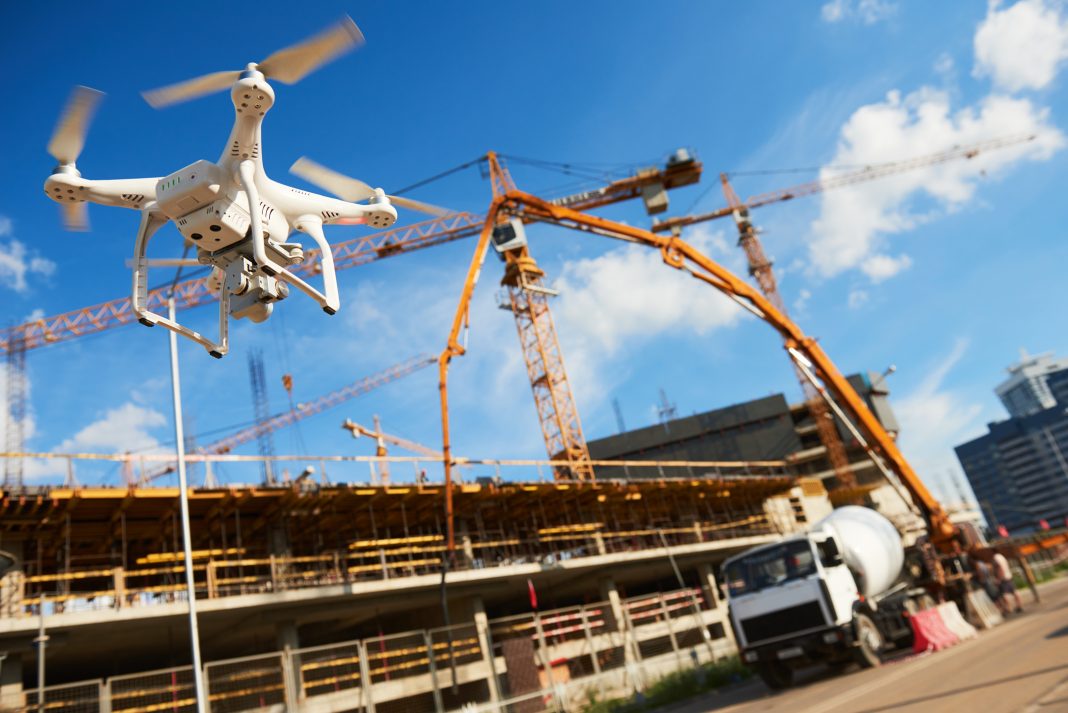The growing adoption of BIM and demand for digital data are fuelling the take-up of drones in the construction industry. Ian Tansey of ProDroneWorx discusses this growing technology and its potential to transform the sector
The construction industry is moving towards to a world where digital information is an essential part of conducting business due to the many benefits it brings. Within this industry, its commercial adoption is being accelerated by the shift towards more and more companies using BIM (Building Information Modelling).
Drone technology is one of the tools a company can use to produce digital data, other methods include ground-based scanning. Drone technology can be deployed very quickly, safely and cost-effectively on any job that requires digital information.
Here are some interesting facts about drone technology:
1. Drones are going to be a major disruptor in the construction industry now and in the coming years. Early and effective implementation of the technology will give companies a significant edge in a very competitive market.
2. According to PwC, drone technologies will upend and reshape construction-related business models. Of all industries, construction has the best prospects for leveraging drone technology.
3. Balfour Beatty is also predicting that drones in the construction industry will play a key part in the digital transformation.
These forecasts and adoption of the technology were confirmed in a recent survey by my own company, ProDroneWorx.
A third of the respondents, which included construction firms, surveyors, architects and engineers, were already using drone technology and, of those that did not, almost 70% of them planned to do so in the near future.
Of the third of respondents that were already using drone technology, the majority (60%) had been using it for less than a year. But an important sub-group of this set (11%) had been using the technology for three to five years – making them very early adaptors indeed.
ProDroneWorx believes that drone technology will transform traditional business models and help digitalise the construction industry. Indeed, early adopters are already starting to see a positive impact on their operational processes from the way projects are understood and monitored to the inspection of assets.
Drones in the construction industry have a wide variety of uses, from 3D modelling (point clouds and textured models), topographical surveys and volume measurement to progress monitoring. Indeed, at nearly every stage of the construction process drones can be of huge benefit, from the planning stage to final construction.
Drone technology and BIM
Although drone technology has many applications within the construction industry, currently its primary use is in photography and video, surveying, asset inspection and progress monitoring.
The technology also has many uses within BIM, for example:
- 3D modelling: 3D models (point cloud, textured model) over large areas or objects can be easily created using drone technology or can be combined with ground-based laser scanning and conventional total station surveying to produce the complete 3D model. 3D models can be imported into BIM or CAD packages so that comparisons can be made with the design plans or it can be used to create an intelligent 3D model.
- Progress monitoring: Drones are the best way for companies to monitor work progress on a project. They provide managers with data to better track a project’s progress, manage resources, reduce downtime and keep projects on schedule and within budget. They also allow teams to verify the ‘as-built’ project status against design models using 2D and 3D data.
- Orthomosaics: High resolution aerial imagery can be captured on the whole project area and all of the images can be merged to form a seamless mosaic. This data can be used within BIM to understand the development area in great detail, while the 2D image is orthorectified so measurements can be taken from it.
Drones are likely to revolutionise construction through the use of 3D modelling, which will reduce the amount of time it takes to design, analyse and maintain a structure, or implement any changes. 3D models are capable of spanning a project’s entire lifecycle, from the initial planning stages through to the operation and maintenance. As a result, onsite and offsite management can enjoy a clearer understanding of a project’s performance by maintaining more consistent data and responding faster to change.
3D models bring the real world or ‘as-build’ into the office and this means that the user can carry out some of the following tasks: appraisal of existing conditions, monitoring construction progress, carrying out structural assessments and recording ‘as-built’ conditions.
In recent years, we’ve seen a lot of improvement in positioning accuracies through the use of ground control points (GCPs) or drones with RTK/PPK built-in, developments of photogrammetry software and the use of LIDAR on drones. 3D point clouds and textured model accuracies have now been demonstrated and validated down to just a few millimetres.
So how can drone technology be used within BIM? Let’s take an existing building where a laser scanner is used to acquire data on the inside while a drone can be used to capture data on the external of the building and the surrounding area. Integrating information from two different datasets enables a complete representation of a building to be achieved. This information can then be used for a variety of purposes, including redesign, visualisation of the building inside and out for prospective customers and as a historical record.
A key benefit of using drone technology, and the specialised photogrammetry software used to create the 2D/3D maps or models, is that the data can be imported into BIM or CAD packages in various file formats, such as dwg, dxf, xyz, las, laz, obj and kmz. This makes integration of the digital 2D/3D data into workflow processes straightforward.
What does the future hold?
Drone adoption is clearly set to grow in the future – and I have no doubt in my mind that we have much more to see in terms of the development of new products and technological innovations.
These technological improvements will make drones fly faster for longer, while also improving safety. The real benefits will come from improvements to the drone itself, with sensors and the use of predicative data analytics to analyse real-time information through machine learning and algorithms.
Ian Tansey
Managing Director
ProDroneWorx
Tel: +44 (0)7805 864642
Twitter: @ProDroneWorx














